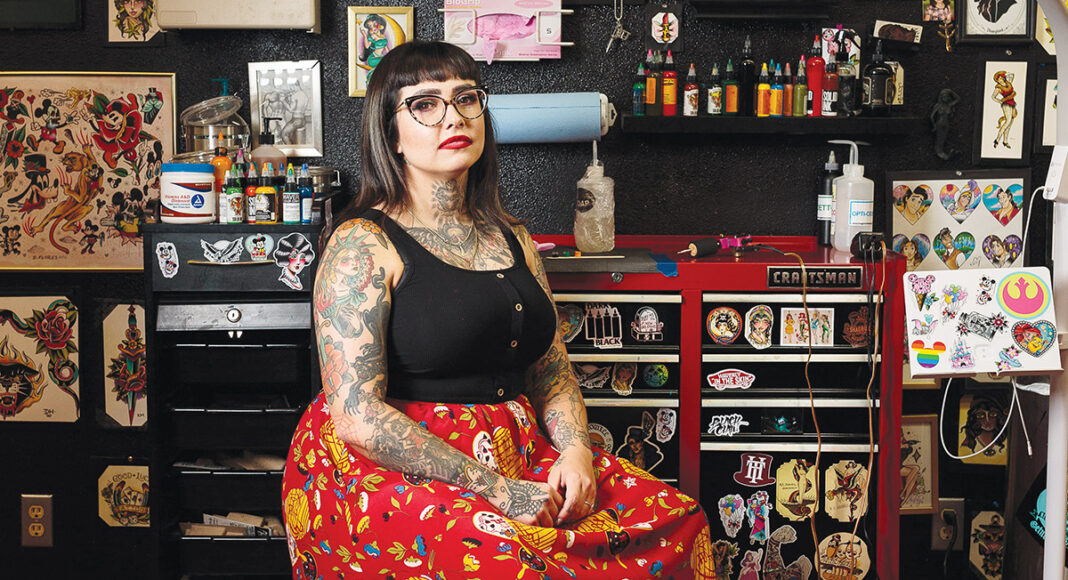No other art form asks more from those who embrace it than tattooing.
Tattoo love comes with three heavy price tags: pain, permanence and intimacy. It figures, then, that people who sport tattoos tend to have relationships with them, or at least stories about them.
For its current exhibit on tattooing, the Museum of Art and History in Santa Cruz could have easily focused on the stunning diversity and creativity of tattoos themselves. But instead, the MAH’s Santa Cruz Tattoo’d is about people, exploring the rich interplay between tattoos and identity.
The exhibit runs through Feb. 23 at the MAH’s third-floor Art Forum Gallery. It consists largely of testimonials from local people who share the unique stories of how they came to be inked.
“We knew we weren’t in a position to do a [comprehensive] history of tattooing,” says the MAH’s Whitney Ford-Terry, who curated the exhibit, “nor a Santa Cruz ‘style’ of tattooing, because there really isn’t one. So when we set out to do this exhibition, we found that the most powerful stories we were getting from people were the circumstances behind why they got a tattoo, or the relationship with whom they got tattooed. The core idea was that tattoos are chosen remembrances.”
On Jan. 30, the MAH will host a screening of the 2010 documentary Tattoo the World, an exploration of the life and art of legendary tattooist Ed Hardy. Heather Baldwin of Good Omen Tattoo in Santa Cruz will be offering live demos in the MAH’s atrium. The event is designed to draw people to the Tattoo’d exhibit. (According to the exhibit’s research, Hardy even showed up in Santa Cruz way back in 1984 for a similar film screening and live demonstration. At that time, the event was not at the local museum, but took place instead at the downtown alternative bookshop Anubis Warpus.)
Among the Santa Cruz tattoo true believers featured in the exhibit are veteran activist and founder of Barrios Unidos Nane Alejandrez, machinist Bobby Magnante, and entrepreneur Kelly McMurray.
Stacy Hernandez talks about the year she lost both her parents and how a tattoo helped her mourn, serving as an ever-present memorial to them. Bonnie Steward used tattoos to express gender identity. Jacquie Benetua-Rolens opted to memorialize an emotionally volatile year by rediscovering her ethnic identity, namely the Filipino tattoo tradition of batok.
Among the local tattoo shops that contributed artwork to the exhibit are Good Omen, Staircase Tattoo, Eights & Aces, Black Pearl, Good Luck Tattoo and several others.
Also featured is a historical component to the exhibit, tracing the controversial history of tattooing in Santa Cruz. Nane Alejandrez was a big part of that history, taking place in tattoo art shows and demonstrations in the early 1980s, when tattooing was technically still illegal in Santa Cruz County. The ban on tattooing was finally lifted in 1986.
The project was the end product of a deep dive into local tattoo culture. “I knew some folks who had done some earlier projects having to do with tattooing a couple of years ago,” says Ford-Terry. “We asked them about some of the local history, spoke with some of the folks at Staircase Tattoo for some recommendations. There were artists who knew artists, who knew artists. We wanted to choose stories that were very different from one another, so the reasoning behind how and why people got tattoos were unique to that person.”
One of the featured artists is Kelly McMurray, the owner/operator of Good Luck Tattoo. “If you’re a tattoo artist,” she says, “mainly, it’s your whole life, almost. Your life revolves around it. It’s hard to get away from. It kinda sucks you in.”
As a small child, McMurray was entranced by other people’s tattoos. She got her first tattoo as soon as it was legal for her to do so. “I made an appointment on my 18th birthday.” She got two small birds on her shoulder. “I cried the whole time,” she says. “I didn’t think it would be that painful.”
The art of tattooing, McMurray says, has turned a corner from a transgressive oddity that few people would purse a few decades ago to a common choice among a wide range of consumers now. “Nowadays, we see people from so many walks of life,” she says. “It’s like a grocery store, or a restaurant. People gotta eat. Well, I feel like nowadays, everybody feels the need to get at least one tattoo.”
“It’s become a lot more widely accepted,” says Whitney Ford-Terry. “The laws have changed. It has a lot to do with social media and the democratizing of images. More people are seeing more people with tattoos. It’s all become normalized.”
A screening of “Tattoo the World,” in support of the exhibit “Santa Cruz Tattoo’d,” will be held at 6pm on Thursday, Jan. 30, at the Museum of Art and History, 705 Front St., Santa Cruz. $10. santacruzmah.org.














